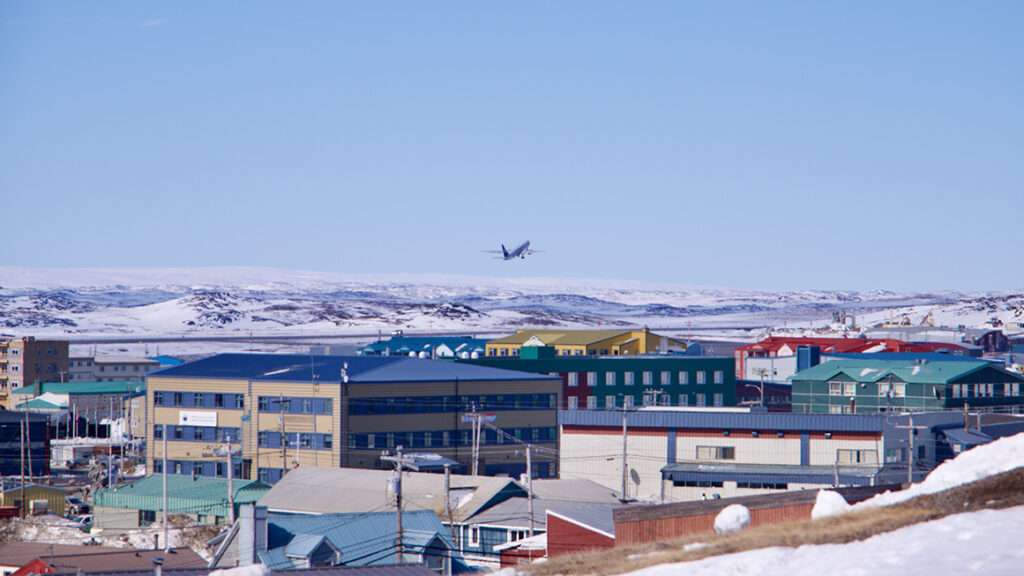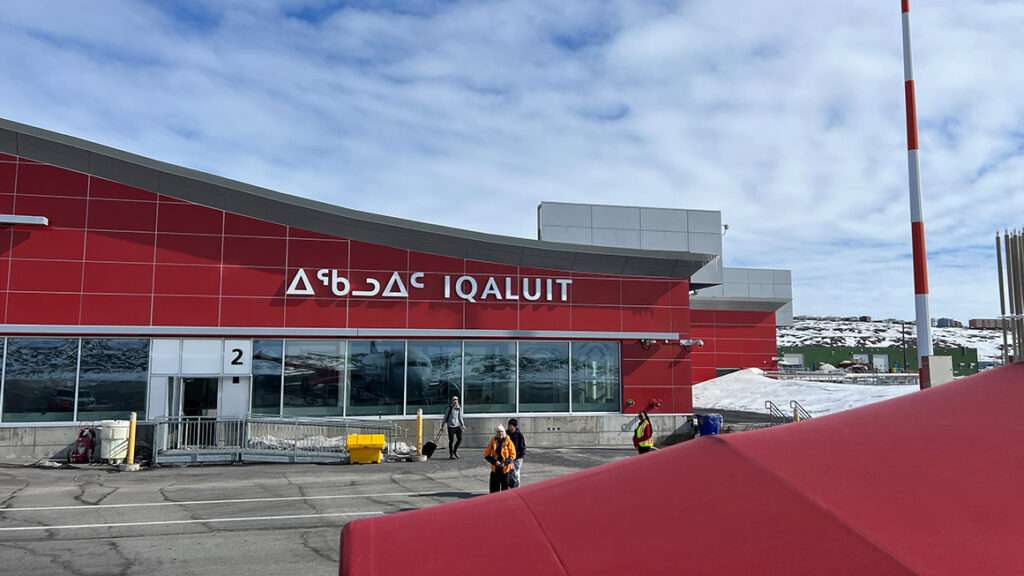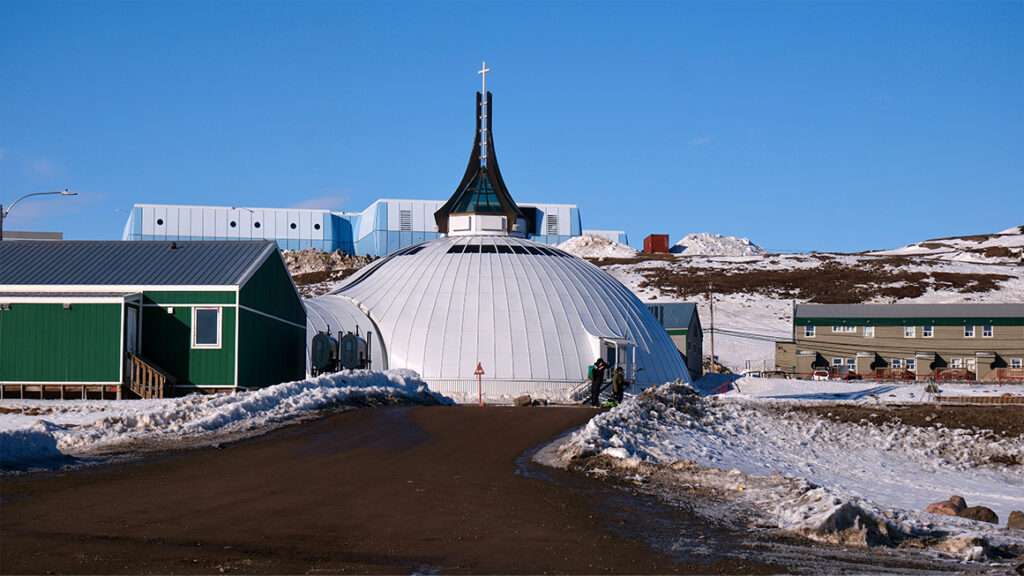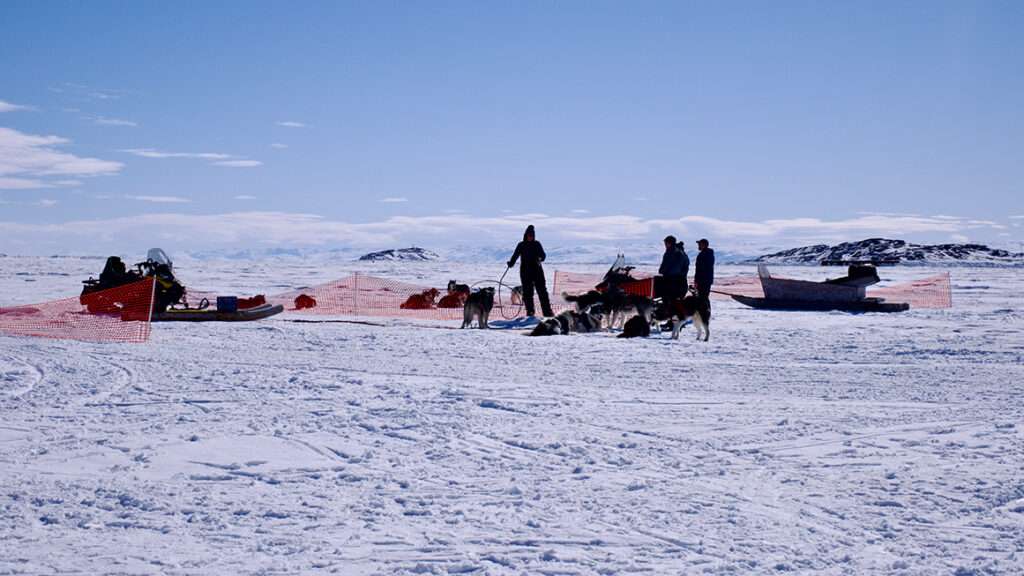This is part of Reason's 2025 summer travel issue. Click here to read the rest of the issue.
On Saturday night, I had Indian food at a mosque potluck. The next day, I went to an African church service full of gospel music. In between, I went to a hockey game and stood on sea ice to watch a dogsled race. That's life in Iqaluit, a Canadian boomtown on the edge of the Arctic.
The semiautonomous Nunavut Territory has always been different from the rest of Canada. The majority of the people there are Inuit (singular: Inuk), a people known for their colorful animal skin fashion, soapstone carvings, and gregarious sense of humor.

"I love traveling in the Arctic. You'll always find something weird in the Arctic. Inuit are something funny," said Inuk comedian Mary-Lee Aliyuk, wearing a sealskin skirt, during the Stand-Up North: Bush Party Baby tour.
On my flight into Iqaluit, announcements were read in English, French, and Inuktitut, the Inuit language. The whole city is filled with signs in the otherworldly Inuktitut ᐃᓄᒃᑎᑐᑦ script. Fresh off the plane, I waited in line at a shop behind a traditionally tattooed Inuk mother wearing an amauti ᐊᒪᐅᑎ, a sealskin parka with a built-in baby pouch just below the hood.
But Iqaluit ᐃᖃᓗᐃᑦ is also distinct within the Arctic. A mining boom and a buildup in the Canadian government's presence has brought a lot of demand for labor to the territorial capital. (Nunavut ᓄᓇᕗᑦ boasted the fastest-growing economy of any Canadian territory or province in 2024.) It's drawing in a diverse and sometimes unexpected collection of people, including immigrants from tropical countries.
This multicultural outpost may be a picture of the future. As climate change shrinks the polar ice caps, governments and business interests are scrambling for a piece of the newly opened frontier. In 2018, China declared itself a "near-Arctic state" and published a grand polar strategy. Both major Canadian political parties are promising a military buildup in the Arctic. U.S. President Donald Trump has infamously threatened to annex both Greenland and Canada.
Different governments have taken different approaches to this competition. Norway is trying to replace immigrants with the "permanent presence of Norwegian citizens" and "family-based community" in Svalbard, an Arctic island traditionally considered a neutral, visa-free territory, New Lines reported in November 2024.
But Nunavut has struck an inviting tone. "Limited local human resources limits the growth of our economy," Annie Cyr-Parent, the territory's director of minerals and petroleum resources, told the Nunavut News in 2024. The Canadian Centre for Economic Analysis estimates that Iqaluit's work force would shrink by 30 percent over the next decade without immigration.
"As Inuit, we know we are always friendly to outsiders," Nunavut Premier P.J. Akeeagok ᐱᔭᐃ ᐊᕿᐊᕈᖅ told Nunatsiaq ᓄᓇᑦᓯᐊᖅ, a local newspaper, in 2022.
Out of 6,870 people in Iqaluit, slightly more than half are Inuit, according to the 2021 census. Among the non-Inuit population, 850 are listed as "visible minorities," including 375 black people, 215 Filipinos, and 95 South Asians. Iqaluit experienced a 110 percent growth in the number of foreign immigrants from 2011 to 2021, and 10 percent of the city's residents are now immigrants.

I visited Iqaluit at the end of Toonik Tyme ᑐᓂᖅ ᑕᐃᒻ, the local spring festival, which happened to line up with Easter this year. (The main character of North of North, an Inuit sitcom filmed in Iqaluit, sums it up as "Whoo-hoo! We didn't die this winter!") The temperature during the day dipped just above freezing, and wet slush dripped down the hills. The surface of Frobisher Bay, however, was still frozen solid. The soundtrack to town was the low rumble of snowmobiles zipping across the sea ice.
'A Lot of GoodWill'
Though Inuit nomads have roamed the area since time immemorial, Iqaluit itself is a relatively new city. With the help of an Inuk guide named Nakasuk ᓇᑲᓱᒃ, the U.S. military established an airfield on the shores of Frobisher Bay during World War II, part of a string of bases stretching from the northwestern U.S. through Canada and Greenland to Europe. A town grew around the air transit hub, and voters chose it as the capital of the new Nunavut Territory in the 1990s.
Islam arrived not too long after. The Pakistani-Canadian boiler inspector Syed Asif Ali founded a mosque, Masjid Iqaluit, in 2015. He had applied for a job listing in Nunavut, not realizing how far north the region was until he found out he couldn't drive to his new hometown. "I tried not to go, but my wife said, you go and establish a mosque," says Ali, who has since left Iqaluit and taken a job as chief gas inspector for the province of Saskatchewan. "The message of Allah has not reached there, and it is our duty to send that message."
There are indeed a handful of Inuit who converted to Islam after the mosque was built, though I couldn't interview any. A mixed Arab-Inuk couple at the mosque declined to be named or quoted for this story, citing privacy. Two other Inuit Muslims had moved out of Iqaluit before I arrived, according to Hussam Beg, a member of the congregation, who gave me a ride to the airport on my last day.
The immigrant Muslim community has also ballooned from around a dozen people when Ali arrived to around 100 people today. Many have had quite roundabout journeys. Mashiur Rahman is a Bangladeshi-Canadian biologist who lived in Ontario before finding a job managing Iqaluit's fisheries. Beg was born in Saudi Arabia, grew up in the United Arab Emirates, lived in the Bahamas, and passed through the United States before getting a job in Iqaluit as a manager for a local private aviation company.*
An information technician from Somalia tells me that his job once sent him to Grise Fiord, the northernmost civilian settlement in Canada, on an island that was completely devoid of human life until the Canadian government exiled some Inuit there in a bizarre 1950s experiment. The average yearly temperature is 2.3 degrees Fahrenheit. Now working in Iqaluit, he plans to retire to sunny Malaysia afterward.
Rahman picked me up from my hotel on my first day in Iqaluit for a tour of the mosque. Perched above Dead Dog Lake on the Road to Nowhere outside town, the mosque shares a parking lot with a small church. Outside, Inuit kids took joyrides on snowmobiles on the frozen lake surface. The sunset lit the hills pink and orange all the way down to Frobisher Bay.

That night the mosque hosted a potluck dinner. The flavors were heavily South Asian, with everyone's favorite being nihari, a slow-cooked mutton stew. Muslims in Inuvik ᐃᓅᕕᒃ, an even more northerly oil boomtown in Canada's Northwest Territories, make Arctic specialties such as reindeer curry, according to The Guardian. But the Iqaluit congregation finds it more difficult to source halal versions of "country food," because hunting rights for non-Inuit are more restrictive than for Inuit.
A banner on the side of the mosque advertises the Arctic Food Bank, which was founded by Muslims in Inuvik and later opened an Iqaluit branch. Nearly 50 percent of Nunavut households suffer from hunger, due to a decline in game animal herds and the high costs of importing anything else. In Iqaluit, the secular Niqinik Nuatsivik Nunavut Food Bank ᓂᕿᓂᒃ ᓄᐊᑦᓯᕕᒃ ᓄᓇᕗᒻᒥ ᓂᕿᑖᕐᕕᒃ opens only once every two weeks, so the Muslims fill in on alternate weeks. "The food bank gets a lot of goodwill," Beg explained to me.
After dinner, Rahman took me to the Toonik Tyme hockey tournament. Teams had flown in from the farthest reaches of the Arctic Circle and from down south in Québéc to compete. Inuit in parkas and sunglasses lined up alongside white Canadians with mullets and baseball caps at the concession stand, staffed by a woman in a hijab.
'Raw Humanity'
The next day was Easter Sunday. I headed to the Catholic parish, where Africans and Filipinos lined up in their Sunday best. Father Barry Bercier was giving a homily about eternal life that seemed applicable to the strange life of the Arctic as well. "It's good to recognize what you don't understand," he said.
After Easter services came the Toonik Tyme dogsled race. A little after noon, locals started to gather in Frobisher Bay awaiting the teams' return from their morning voyage across the sea ice. I trekked out onto the frozen harbor, following the tracks left by snowmobiles to the finish line. Others showed up on cross-country skis and a pickup truck. The finish line was marked with orange plastic webbing next to a parking lot carved into the sea ice. By Iqaluit standards, it was a hot day; one of the skiers was stripped down to shorts and a sleeveless undershirt.
Later I returned to the church, where two Cameroonian boys helped me find the entrance to the rectory. I was going to meet with Bercier, and the boys were going to a church group that shares building space with the Catholic parish. The group sang and danced to the lead of a female preacher, who invited everyone to "come to the table of Christ, regardless of denomination."

Hailing from Worcester, Massachusetts, Bercier has been "obsessed" with the Arctic for decades. Over the years, he has gotten himself assigned to Nuuk, Greenland; Pituffik Space Base, the U.S. ice fortress in Greenland formerly known as Thule Air Base; and Igloolik ᐃᒡᓗᓕᒃ, Nunavut.
Most Inuit in Nuuk and Iqaluit belong to Protestant denominations—the igloo-shaped Anglican cathedral is the most famous landmark in Iqaluit—so the Catholics there are almost all foreigners. Many Catholics in both Nuuk and Iqaluit are workers from the Philippines, a country famous for exporting labor.
"It was Philippine National Day my first summer in Greenland, and on Sunday after church, they all paraded up to my apartment, which was upstairs of the church, with a whole roast pig. And they came in and laid banana leaves on the kitchen table and placed the pig on the banana leaves," Bercier said. "I said, 'Where in Greenland did you get banana leaves? And the pig?' They didn't tell me. They just laughed."
Igloolik, on the other hand, had an all-Inuit Catholic congregation in what Bercier calls "the most Inuit of all towns." There, he preached with the help of an Inuktitut translator. In the north, he says, "There's something beautiful, something mysterious—there's a sense of holiness that can pervade things."
'Why Not Here?'
Ali, the founder of the mosque, had similar feelings. Inuit culture, he said, was more "natural" and "not exposed to the mentality of big cities."
This isn't to say that race relations are always kumbaya. Resentments sometimes flare up, behind closed doors or during heated moments. There are the expected tensions when newcomers, whether foreign- or Canadian-born, take highly paid jobs while so many Inuit live a subsistence lifestyle. "Transient settlers," wrote former Nunavut official Kunuk Inutiq ᑯᓄᒃ ᐃᓅᑎᖅ in 2022, "generate wealth from our lands and resources and leave the scraps and waste for the Inuit."
A particularly sensitive issue is the competition between the English and Inuktitut languages. In the early 20th century, the Canadian government tried to forcibly assimilate natives to the white Canadian way of life. Children were sent to the infamous "residential schools," where conditions were harsh and native languages banned.
The government of Nunavut reversed course completely—official documents and public education are now offered in Inuktitut—but the language is still slightly declining, according to 2021 census data. An Inuk clerk at a store complained to me about outsiders "who come in speaking English and expecting to be spoken to in English" at a time when Inuit are trying to revive their language.
Still, many outsiders are there for the long haul and are accepted into the community. The cash register at Yummy Shawarma, a Lebanese restaurant near the airport, is decorated with a sealskin pouch, a collection of traditional Inuit ulu ᐅᓗ knives shaped like the half-moon, and a little statue of a hunter. When I visited, Arabic music was blaring from the speakers, occasionally interrupted by the sound of a bush plane taking off.
"Why here? Why not here?" Yummy Shawarma owner Khaldoun El-Shamaa told me between warm greetings to his regular customers. "I've been here 18 years, I love it. It's a small community." He added that, though he's "not fluent" in Inuktitut, he "speaks a little."
One night I took a cab back from photographing the northern lights over the harbor. The driver was Nigerian by way of Toronto. "This is my home now. I love it here," he said.
"Who doesn't?" piped up my fellow passenger, a young Inuk woman.
The driver agreed. "How can anyone come here and not see it is an amazing place with amazing people?"
*CORRECTION: This article mischaracterized the company that Hussam Beg works for.
The post Why Are Immigrants From Tropical Countries Coming to This Arctic Outpost? appeared first on Reason.com.







